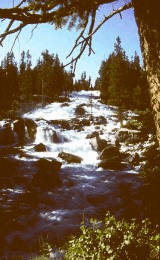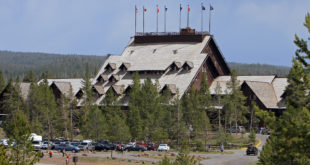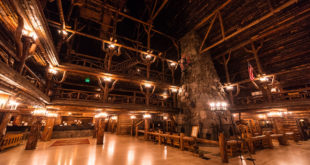 Spring: For the visitor spring in Yellowstone begins when the roads open and park services become available. (There are some periods in very early spring when snowmobiles can still negotiate the roads, but as they turn slushy and develop bare spots, that traffic ends.) The National Park Service opens the roads in segments, for example from West Yellowstone to Old Faithful, and from Mammoth to Norris. The process of plowing and opening can take about a month, so if you come in early-April to mid-May, there may be portions of the park that are not yet open.
Spring: For the visitor spring in Yellowstone begins when the roads open and park services become available. (There are some periods in very early spring when snowmobiles can still negotiate the roads, but as they turn slushy and develop bare spots, that traffic ends.) The National Park Service opens the roads in segments, for example from West Yellowstone to Old Faithful, and from Mammoth to Norris. The process of plowing and opening can take about a month, so if you come in early-April to mid-May, there may be portions of the park that are not yet open.
If you think of spring as the time when snow is gone and the plant life is greening, Yellowstone’s spring is very dependent on elevation. Spring usually comes to Mammoth Hot Springs (at 6,300 ft./1900 m) in March and early April. On the Mt. Washburn road at Dunraven Pass (8,859 ft./2700 m), spring may be delayed until mid June. Don’t be surprised to see remnant snow even as late as the end of June.
The weather in spring is extremely variable, with bright sunshine and sixty degrees one day, thunderstorms the next, and a major snowfall on another day. One thing for certain, spring is the wettest time of year and the buggiest (mosquitoes). It is also the best time of year to see animals, as they are still concentrated in the valleys and wintering grounds and have not yet become spooked by hordes of humans. Spring in Yellowstone was once almost as devoid of people as winter, but in the last few decades photographers, amateur naturalists, and people who have a special fondness for nature have discovered the advantages of being an early visitor to the park.
INSIDER TIP: In the two weeks between (roughly) June 8 and June 22, most of the park services are open (or opening), the roads are all open, the weather is warmer (but may still be stormy), and the summer crowds have not arrived. This is a comfortable time to come to the park to see animals, flowers, and snow capped mountain scenery.
 Summer: The kids are out of school. It’s warm in Yellowstone. It’s the time when about 2.5 million out of the 3 million people who visit Yellowstone come to the park. Depending on how you look at it, this may be one of the negatives. It certainly is a factor when it comes to making reservations for lodging, finding a campsite, and driving the park roads. The weeks with the most visitors are from mid-July to mid-August.As far as park services are concerned, the peak summer season in Yellowstone arrives around July 1 and ends at Labor Day. As far as the weather is concerned, these dates are a reasonable approximation for high summer, although warm summer-like weather can start in early June and end late in September.
Summer: The kids are out of school. It’s warm in Yellowstone. It’s the time when about 2.5 million out of the 3 million people who visit Yellowstone come to the park. Depending on how you look at it, this may be one of the negatives. It certainly is a factor when it comes to making reservations for lodging, finding a campsite, and driving the park roads. The weeks with the most visitors are from mid-July to mid-August.As far as park services are concerned, the peak summer season in Yellowstone arrives around July 1 and ends at Labor Day. As far as the weather is concerned, these dates are a reasonable approximation for high summer, although warm summer-like weather can start in early June and end late in September.
INSIDER TIP: There are reasons why so many people go to Yellowstone in mid-summer. Services are readily available, including ranger talks and private tours. It’s a comfortable time of year with reliably pleasant weather. Animals can still be seen. And of course, it’s the time when people can more easily arrange their vacations. On the other hand, it’s not the best time for many natural features in the park. For example, by the middle of summer it’s dry and often hot, so most anything to do with water – geyser height, waterfall size, river depth – may be reduced. Many of the herd animals such as bison and elk have migrated to higher (cooler and greener) terrain and most animals have learned to avoid concentrations of human beings. Our tip: target June 20 – July 4 for your visit. It’s ahead of the rush. The kids are out of school. The weather is usually summery. There are more animals and there is more water -– the park is lush, bursting with flowers, and green.
 Fall: In Yellowstone, autumn is the time between the end of summer heat and the first permanent snow. This can be about two weeks apart, say from October 1 to October 15. However, most years it stretches from mid-September to mid-November. There are two realities that must play a part in planning an autumn visit: It can snow any time, which affects driving conditions, and services (lodging, restaurants, stores, and gas stations) start closing or reduce hours. The timing of snow and service reduction varies from year to year –- so fall visitors keep an eye on weather forecasts and park schedules. As it is in most of the United States, fall is the traditional travel season for retired people in Yellowstone. In general, traffic is way down, animals are returning from the high country to the valleys (where most of the roads are), the weather is crisp but often surprisingly warm during the day. For many people this is a favorite time of year. Most of Yellowstone is pine forest, so other than an occasional golden aspen, there is no “color season.”
Fall: In Yellowstone, autumn is the time between the end of summer heat and the first permanent snow. This can be about two weeks apart, say from October 1 to October 15. However, most years it stretches from mid-September to mid-November. There are two realities that must play a part in planning an autumn visit: It can snow any time, which affects driving conditions, and services (lodging, restaurants, stores, and gas stations) start closing or reduce hours. The timing of snow and service reduction varies from year to year –- so fall visitors keep an eye on weather forecasts and park schedules. As it is in most of the United States, fall is the traditional travel season for retired people in Yellowstone. In general, traffic is way down, animals are returning from the high country to the valleys (where most of the roads are), the weather is crisp but often surprisingly warm during the day. For many people this is a favorite time of year. Most of Yellowstone is pine forest, so other than an occasional golden aspen, there is no “color season.”
INSIDER TIP: Mid-September, stretched from right after Labor Day to about the 20th is a time when many of the park services are available, but the crowds have gone. Snow is possible, especially in the higher elevations of the park, but it won’t stay. There are few bugs, more animals, and many glorious warm and sunny days.
 Winter: Until about forty years ago, most of Yellowstone National Park was shut down in winter. The exception was traffic to Old Faithful by snow coaches, mostly from West Yellowstone. It’s a bit different now. Although restricted, private snowmobiles and snow coaches bring many visitors into the park during winter from all points of the compass. Park and gateway city services have adjusted -– more lodging, restaurants, and stores stay open all year or have a special winter season.
Winter: Until about forty years ago, most of Yellowstone National Park was shut down in winter. The exception was traffic to Old Faithful by snow coaches, mostly from West Yellowstone. It’s a bit different now. Although restricted, private snowmobiles and snow coaches bring many visitors into the park during winter from all points of the compass. Park and gateway city services have adjusted -– more lodging, restaurants, and stores stay open all year or have a special winter season.
For visitors, winter in Yellowstone starts with the first permanent snows that close roads and ends in early spring when park service plows reopen the roads, which is about as indefinite a period as it sounds. In general, (very general) the heavy snowfalls begin in late October but the park may close roads almost any time after October 15. The plows go out in early-April most years, but roads reopen by segments, which for the higher reaches of Mt. Washburn can be as late as mid-May. There is one segment of park road open all winter from Mammoth (park headquarters) to the small Montana community of Cooke City just beyond the Northeast Entrance of the park.
Because of its elevation, Yellowstone has real winters with lots of snow and cold. If it’s tough on human beings, think of the animals. Yet winter is beautiful, stunning. The slim water columns of the summer geysers become massive towering clouds of steam in winter. Geyser basins become magical landscapes of snow drifts, bare ground, constantly shifting wisps of steam, and snow laden trees. Winter in Yellowstone is another world – and must be treated as such. Everything about winter, from transportation, to lodging, to activities, to survival skills is different.
[Photos: Crazy Creek, Beartooth Mountains (at the Clarks Fork River); Fountain Geyser, Lower Geyser Basin (Fountain Paint Pot area); Autumn in the Lamar Valley, Lamar River; Geyser Steam in the Snowy Pines, Norris Geyser Basin. N. King]
 Yellowstone Insider Your Complete Guide to America's First National Park
Yellowstone Insider Your Complete Guide to America's First National Park






